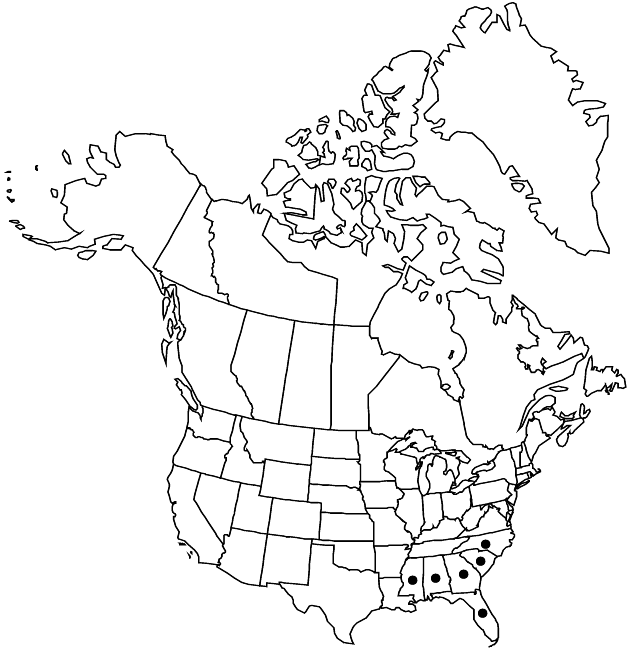Difference between revisions of "Pterocaulon pycnostachyum"
Sketch Bot. S. Carolina 2: 324. 1823.
FNA>Volume Importer |
imported>Volume Importer |
||
| (6 intermediate revisions by 2 users not shown) | |||
| Line 8: | Line 8: | ||
}} | }} | ||
|common_names=Fox-tail or coastal blackroot | |common_names=Fox-tail or coastal blackroot | ||
| − | |basionyms={{Treatment/ID/ | + | |special_status={{Treatment/ID/Special_status |
| + | |code=E | ||
| + | |label=Endemic | ||
| + | }} | ||
| + | |basionyms={{Treatment/ID/Basionym | ||
|name=Conyza pycnostachya | |name=Conyza pycnostachya | ||
|authority=Michaux | |authority=Michaux | ||
| + | |rank=species | ||
| + | |publication_title=Fl. Bor.-Amer. | ||
| + | |publication_place=2: 126. 1803 | ||
}} | }} | ||
|synonyms={{Treatment/ID/Synonym | |synonyms={{Treatment/ID/Synonym | ||
|name=Pterocaulon undulatum | |name=Pterocaulon undulatum | ||
|authority=C. Mohr | |authority=C. Mohr | ||
| + | |rank=species | ||
}} | }} | ||
|hierarchy=Asteraceae;Asteraceae tribe Plucheeae;Pterocaulon;Pterocaulon pycnostachyum | |hierarchy=Asteraceae;Asteraceae tribe Plucheeae;Pterocaulon;Pterocaulon pycnostachyum | ||
| Line 30: | Line 38: | ||
|elevation=0–20 m | |elevation=0–20 m | ||
|distribution=Ala.;Fla.;Ga.;Miss.;N.C.;S.C. | |distribution=Ala.;Fla.;Ga.;Miss.;N.C.;S.C. | ||
| − | |discussion=<p>Differences between Pterocaulon pycnostachyum and P. alopecuroides (Lamarck) de Candolle, which is widespread in the West Indies and South America, are these: plants 50–70 cm high in P. pycnostachyum (versus 70–150 cm in P. alopecuroides), arrays of heads 4–8 cm (versus 3–17 cm) long, involucres 3.5–4 mm (versus 4.5–5 mm) high, and 6–15 (versus 1–3) functionally staminate florets (A. L. Cabrera and A. M. Ragonese 1978). In P. alopecuroides, the arrays of heads are almost always interrupted proximally, commonly producing sessile to subsessile branches. A count of functionally staminate florets provides a clear determinant for plants that might appear ambiguous in other features.</p> | + | |discussion=<p>Differences between <i>Pterocaulon pycnostachyum</i> and <i>P. alopecuroides</i> (Lamarck) de Candolle, which is widespread in the West Indies and South America, are these: plants 50–70 cm high in <i>P. pycnostachyum</i> (versus 70–150 cm in <i>P. alopecuroides</i>), arrays of heads 4–8 cm (versus 3–17 cm) long, involucres 3.5–4 mm (versus 4.5–5 mm) high, and 6–15 (versus 1–3) functionally staminate florets (A. L. Cabrera and A. M. Ragonese 1978). In <i>P. alopecuroides</i>, the arrays of heads are almost always interrupted proximally, commonly producing sessile to subsessile branches. A count of functionally staminate florets provides a clear determinant for plants that might appear ambiguous in other features.</p> |
|tables= | |tables= | ||
|references= | |references= | ||
| Line 39: | Line 47: | ||
-->{{#Taxon: | -->{{#Taxon: | ||
name=Pterocaulon pycnostachyum | name=Pterocaulon pycnostachyum | ||
| − | |||
|authority=(Michaux) Elliott | |authority=(Michaux) Elliott | ||
|rank=species | |rank=species | ||
| Line 53: | Line 60: | ||
|publication title=Sketch Bot. S. Carolina | |publication title=Sketch Bot. S. Carolina | ||
|publication year=1823 | |publication year=1823 | ||
| − | |special status= | + | |special status=Endemic |
| − | |source xml=https:// | + | |source xml=https://bitbucket.org/aafc-mbb/fna-data-curation/src/2e0870ddd59836b60bcf96646a41e87ea5a5943a/coarse_grained_fna_xml/V19-20-21/V19_799.xml |
|tribe=Asteraceae tribe Plucheeae | |tribe=Asteraceae tribe Plucheeae | ||
|genus=Pterocaulon | |genus=Pterocaulon | ||
Latest revision as of 19:56, 5 November 2020
Plants 2–8 dm. Leaf blades lanceolate to obovate-lanceolate, oblong, or elliptic, 3–11 × 1–3(–3.5) cm, lengths mostly 2–7 times widths, margins usually dentate or denticulate, slightly repand, sometimes nearly entire. Heads in dense, usually continuous, rarely interrupted (then near bases), narrow, ± ovoid arrays (2–)3–8(–10) cm (usually single, sometimes with 1–2 basal branches). Involucres campanulate, 4–5 mm. Pistillate florets 23–44. Functionally staminate florets 6–10(–15). Cypselae 1–1.3 mm. 2n = 20.
Phenology: Flowering May–Jun.
Habitat: Sandy pinelands, sandy fields, depressions, ditches
Elevation: 0–20 m
Distribution

Ala., Fla., Ga., Miss., N.C., S.C.
Discussion
Differences between Pterocaulon pycnostachyum and P. alopecuroides (Lamarck) de Candolle, which is widespread in the West Indies and South America, are these: plants 50–70 cm high in P. pycnostachyum (versus 70–150 cm in P. alopecuroides), arrays of heads 4–8 cm (versus 3–17 cm) long, involucres 3.5–4 mm (versus 4.5–5 mm) high, and 6–15 (versus 1–3) functionally staminate florets (A. L. Cabrera and A. M. Ragonese 1978). In P. alopecuroides, the arrays of heads are almost always interrupted proximally, commonly producing sessile to subsessile branches. A count of functionally staminate florets provides a clear determinant for plants that might appear ambiguous in other features.
Selected References
None.